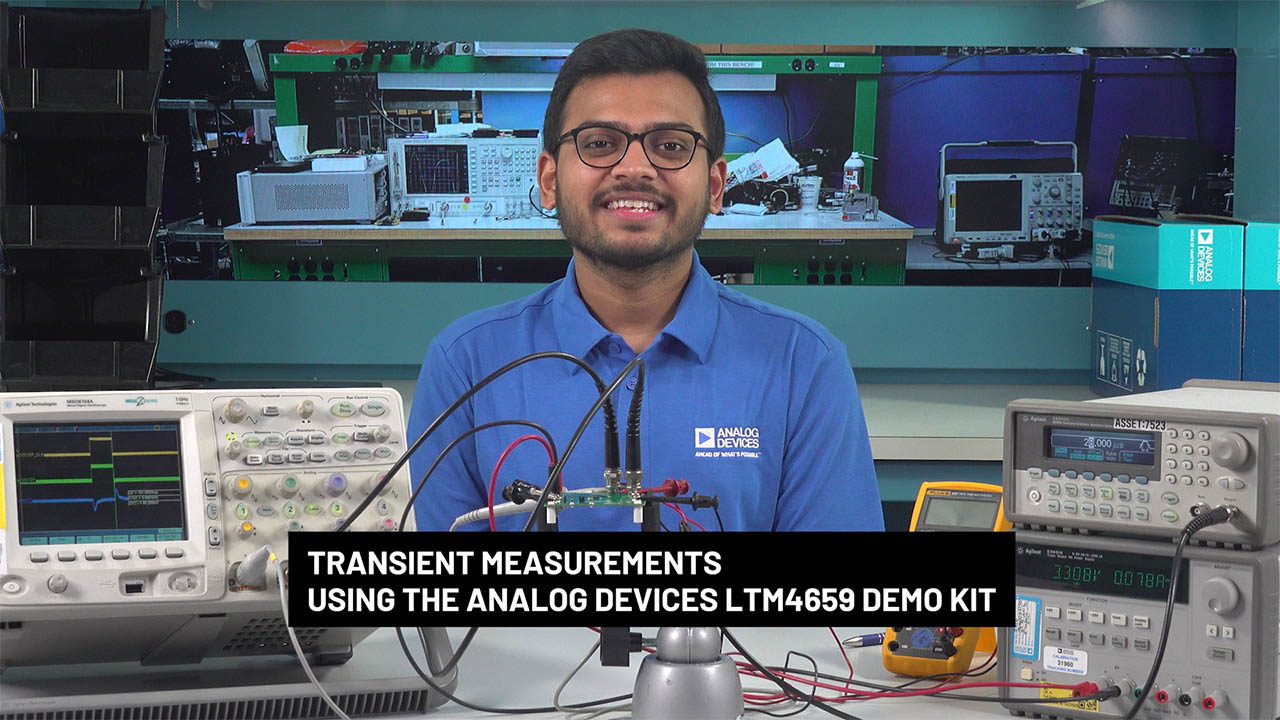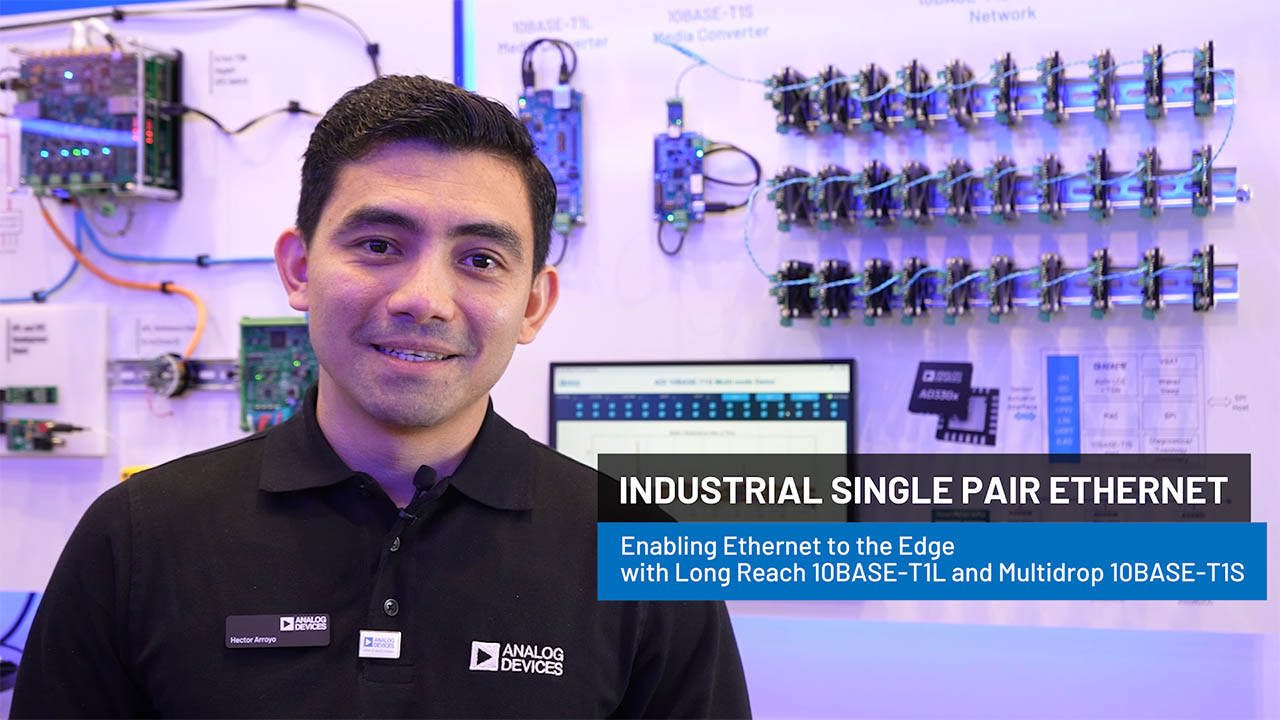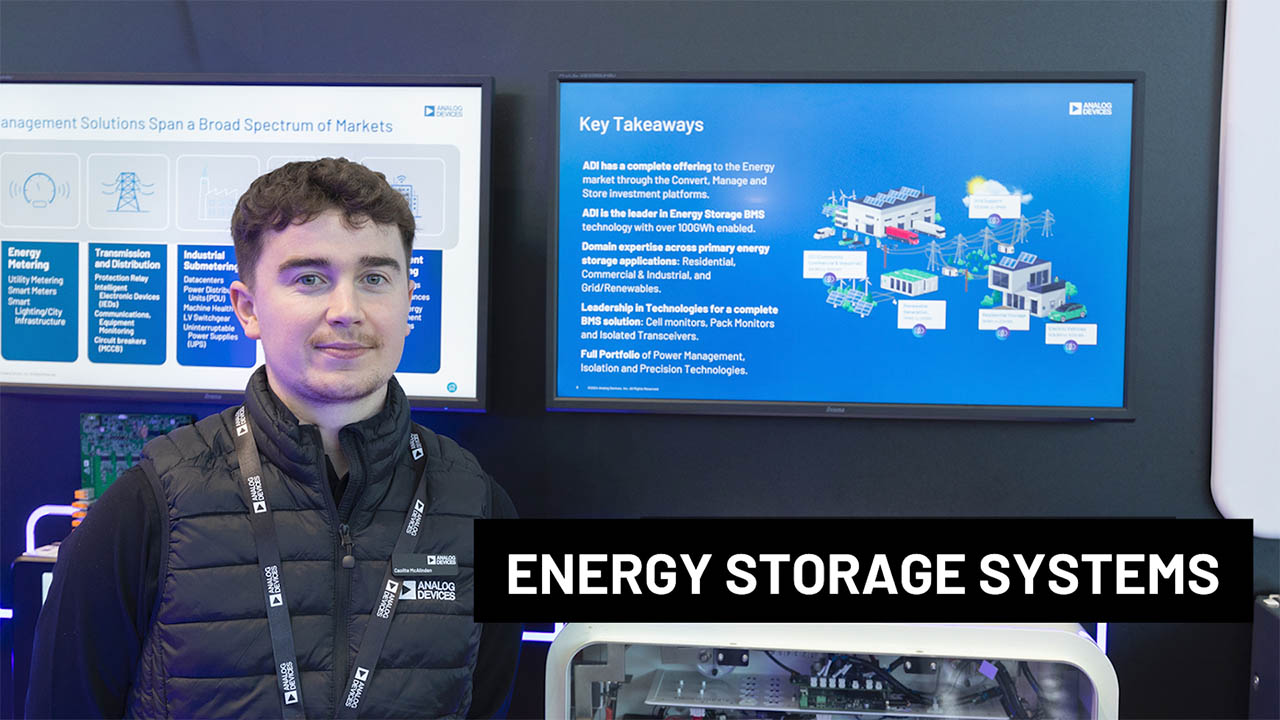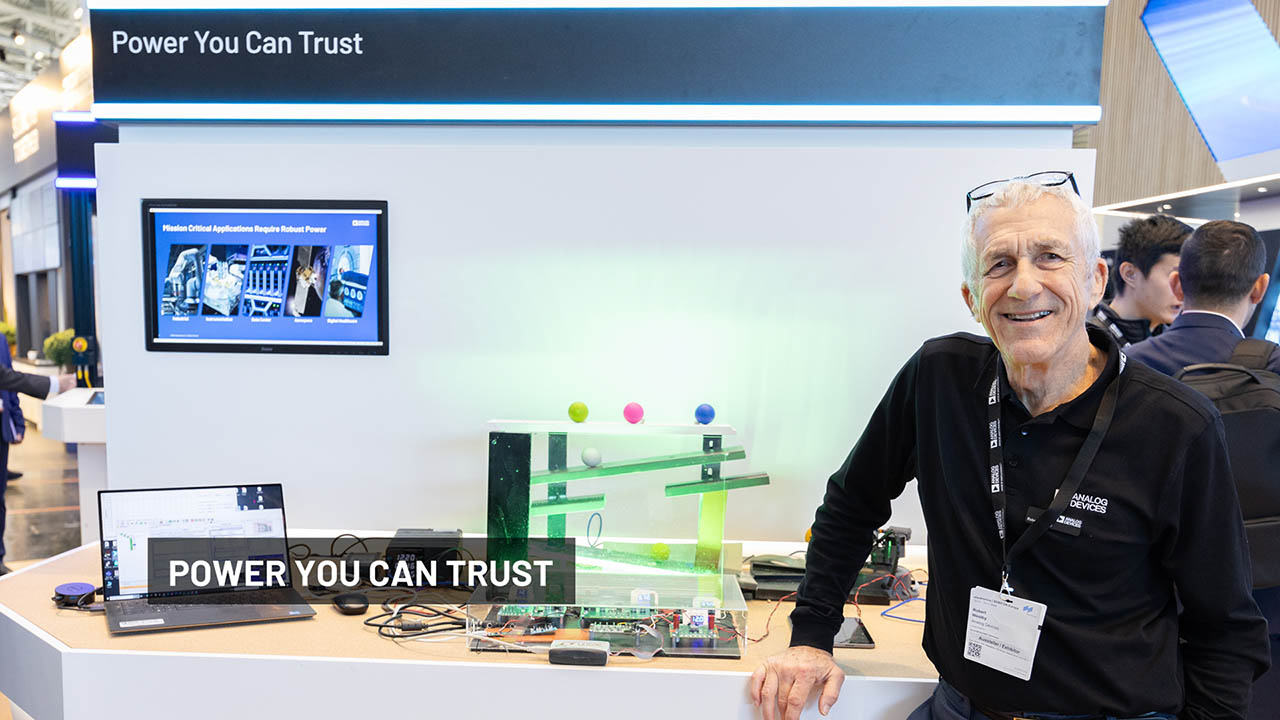Isolated Data Transmission and Power Conversion Integrated Into a Surface Mount Package
Isolated Data Transmission and Power Conversion Integrated Into a Surface Mount Package
2011-01-01
Galvanic isolation is used in a variety of industries, most commonly to provide safety against potentially lethal voltages. Isolation is also used to eliminate the effects of noise and common mode voltage differences created by ground loops, or as a level shifter between dissimilar operating voltages. Typically, building an isolated system requires a number of passive and active components on either side of the isolation barrier, in addition to the barrier components themselves. These barrier components can be optical, magnetic, capacitive, RF or even GMR (giant magnetoresistance) devices.
Barrier components are notoriously difficult to use, adding significant design time and cost to isolated systems. With this in mind, Analog Devices has developed a line of μModule® isolators that reduces the design of isolated systems to simply plugging in a module—no complex barrier components are required. In fact, μModule isolators require no external components at all.
Analog Devices μModule isolators use magnetically coupled techniques to provide data and power isolation in a single package. The result is an easy-to-use, low power, robust solution with excellent field immunity. The LTM2881 isolated RS485/RS422 transceiver and LTM2882 dual isolated RS232 transceivers use μModule isolator technology to provide complete transceiver-plus-power solutions in 15mm × 11.25mm × 2.8mm surface mount packages.
Isolated Data Transmission
μModule isolators use inductively coupled coils, or coreless transformers, to pass data across the isolation boundary. Electrical and mechanical representations are illustrated in Figure 1. Dedicated integrated circuits perform the data transmission and receiving functions for all channels and both data directions.

Figure 1. Data isolation equivalent electrical and mechanical configuration.
Three channels of data are encoded, serialized into a packet, and transmitted across the isolation boundary in each direction. Data transmission in one direction is completely independent of data transmission in the other direction.
The encoding process is initiated when the data changes (edge triggered) on any of the three inputs. The three data inputs consist of one high priority and two low priority channels. A state change on the high priority channel preempts an encoding process initiated by a low priority channel state change. This scheme ensures that the data on the high priority channel is transmitted with no jitter to the output, but in turn produces some amount of timing uncertainty on the low priority channels. The high priority channel is assigned to DI to (Y,Z) and (A,B) to RO for the LTM2881, and from T1IN to T1OUT and R1IN to R1OUT for the LTM2882. All remaining channels for these products are low priority. Encoding is completed by sampling all three input data states and transmitting the data across the coreless isolation transformer as a series of pulses.
Each transmission is received as a differential signal, checked for errors, decoded, and clocked to the associated data output. The receiver is connected to a center tapped transformer secondary. This winding arrangement provides common mode rejection since any coupled signals are cancelled by the opposing winding geometry at the receiver input. The error checking process determines if the transmitted data is valid; if not, the outputs are not updated.
The encoding/decoding process supports a minimum data throughput rate of approximately 21Mbps. Edge events occurring during a packet transmission initiate a new capture operation, which is completed at the end of the current transmit cycle.
Data is refreshed at a rate of approximately 1MHz, ensuring DC correctness of all data outputs. If four invalid packets are received in succession then a communication fault is generated. This fault mode forces a high impedance state on certain outputs, for instance RO and DOUT for the LTM2881, and R1OUT and R2OUT for the LTM2882. This fault condition can be easily detected in critical applications.
The coreless transformer is fabricated within the μModule substrate’s inner layers. Minimum coil layer separation of 60μm is provided by a 2-ply Bismaleimide-Triazine (BT) high performance resin-based laminate.
Isolated Power Transmission
Isolated power is generated by more conventional means. The overall power converter consists of a full-bridge square wave oscillator AC-coupled to an isolation transformer primary, rectified with a full wave voltage doubler connected to the transformer secondary, and post regulated by a low-dropout linear regulator (LDO). Figure 2 schematically shows the power conversion stage.

Figure 2. Simplified isolated power conversion stage.
The overall power topology provides a simple, flexible, fault tolerant and relatively efficient design (~65%). Bridge current is monitored and limited to protect the power switches and transformer. The primary and secondary are both AC-coupled, preventing transformer saturation under any condition. All components are integrated within the μModule package; no external decoupling is required for proper operation.
Two input operating voltage ranges, determined by transformer turns ratio, are available: 3V to 3.6V (-3 versions) and 4.5V to 5.5V (-5 versions). Input voltage level is internally sensed, setting the primary current limit to approximately 550mA for -3 part versions and 400mA for -5 part versions. The converter output power capability versus input voltage is shown in Figure 3 for VCC2 ≥ 4.75V.

Figure 3. μModule isolator power capability.
Primary current limit is not active under normal operating conditions.
The transformer comprises a toroidal ferrite core with one high voltage insulated winding and a second low voltage insulated winding. The high voltage winding uses supplementary-rated Teflon-insulated wire, consisting of two independent layers with a total insulation thickness of 76μm. The transformer is completely encapsulated during the μModule molding process, providing additional protection.
Isolation Barrier Performance
As detailed above, the isolation barrier consists of two components: data coils insulated by BT substrate, and Teflon insulated windings within the power transformer. The isolation barrier is designed to have a minimum dielectric withstand rating of 2500VRMS for sixty seconds, and continuous working voltage of 400VRMS or 560VPEAK.
Key isolation parameters are listed in Table 1, adopted from a wide variety of international standards. Standards relevant to isolation systems and components, and related topics of interest are listed in Table 2.
| Parameter | Conditions | Min | TYP | Max | Unit |
| Rated Dielectric Insulation Voltage | 1 Minute | 2500 | VRMS | ||
| Maximum Working Insulation Voltage | Continuous | 400 560 |
VRMS VPEAK |
||
| Partial Discharge | VPR = 1050VPEAK | 5 | pC | ||
| Common Mode Transient Immunity | 30 | kV/μs | |||
| Input to Output (Insulation) Resistance | VIO = 500V | 109 | 1011 | Ω | |
| Input to Output (Barrier) Capacitance | f = 1MHz | 6 | pF | ||
| External Tracking (Creepage) Distance | L/BGA | 9.53 | mm | ||
| External Air Gap (Clearance) Distance | BGA | 9.53 | mm | ||
| Comparitive Tracking Index (CTI) | 175 | V | |||
| Highest Allowable Overvoltage | t = 10s | 4000 | VPEAK | ||
| Minimum Distance Through Insulation | 0.06 | mm | |||
| Isolation Barrier ESD, HBM | (VCC2, GND2) to GND Isolated I/O to GND |
±10 ±8 |
kV kV |
| Standard | Description |
| UL1577 | Standard for Safety, Optical Isolators |
| IEC 60747-5-2 (VDE 0884-10) | Optoelectronic Devices, Essential Ratings and Characteristics |
| IEC 60664-1 | Insulation Coordination for Equipment within Low-Voltage Systems |
| IEC 60950-1 | Information Technology Equipment—Safety |
| IEC 61010-1 | Measurement, Control, Laboratory Equipment—Safety |
| IEC 60601-1 | Medical Electrical Equipment |
| IEC 61000-4-2 | Electrostatic Discharge Immunity |
| IEC 61000-4-3 | Radio Frequency Field Immunity |
| IEC 61000-4-4 | Electrical Fast Transients |
| IEC 61000-4-5 | Surge Immunity |
| IEC 61000-4-8 | Power Frequency Magnetic Field Immunity |
| IEC 61000-4-9 | Pulse Magnetic Field Immunity |
| CISPR 22 | Radiated Emissions - Information Technology Equipment |
| IEC 60079-11 | Intrinsic Safety |
UL1577 is a component level standard designed to verify that the dielectric withstands voltages of up to 2500VRMS under a variety of environmental conditions. The LTM2881 and LTM2882 devices have achieved UL approval up to an operating temperature of 100ºC. The dielectric withstand is 100% production tested by applying a DC test voltage of ±4400V (≈2500 • 1.2 • √2) for one second at each polarity, with all pins shorted on each side of the isolation barrier.
IEC 60747-5-2 is the European equivalent component level standard, requiring a measurement of partial discharge (PD) across the isolation barrier at a voltage related to the rated system working voltage. Tests under a variety of environmental conditions are required for certification, as well as 100% production screening. The LTM2881 and LTM2882 have been characterized for PD and easily meet the requirements of the standard, with less than 5pC at 1050VPEAK for a working voltage of 560VPEAK. Certification to IEC 60747-5-2 is in process.
The rated continuous working voltage is not explicitly defined in any standard; its value is dependent on a variety of environmental operating conditions, including creepage/clearance, test requirements defined within the standards, as well as the operational lifetime. The operating lifetime at the rated working voltage is extrapolated from accelerated lifetime test data. Tests results for the LTM2881 and LTM2882 are shown in Figure 4. Data conforms to the generally accepted Weibull distribution for accelerated dielectric breakdown testing.1 The plot shows the minimum lifetime at 500VRMS is greater than 100 years.

Figure 4. μModule isolator insulation lifetime.
Parameters related to the isolation barrier voltage rating include electrostatic discharge (ESD), surge immunity, and electrical fast transients. One of the major benefits of galvanic isolation is the ability of the isolation barrier to hold off large voltage potentials, eliminating the need for other protection devices such as transient voltage suppressors. The key is configuring the system in a way that the barrier sees the transient event, which is typically achieved by proper shielding of system interconnects. The isolation barrier easily withstands transient events equal to the dielectric withstand voltage of 2500VRMS or 3500VPEAK, and can withstand much higher voltages for short periods of time as evidenced by the 8kV–10kV barrier ESD ratings, and operating lifetimes at elevated voltages.
The input to output capacitance, or barrier capacitance, is an important parameter impacting many aspects of overall performance. In general, the lower the capacitance the better. The capacitance is a parasitic element and is the parallel combination of data coil and transformer winding capacitance. Typical capacitance is 6pF at 1MHz with the data coils accounting for 1.2pF each and the power transformer 3.6pF. In the case of transients, one or more ESD or body diodes conducts the transient energy to the barrier capacitance and back to ground. A smaller barrier capacitor absorbs more transient voltage, reducing the energy dissipated in the functional IC, thus minimizing the potential for damage.
The magnitude of capacitance also impacts the common mode transient immunity. This parameter is a measure of the component’s ability to maintain proper function in the presence of high slew rate signals across the isolation barrier. μModule isolators support a minimum common mode transient rate of 30kV/μs (50kV/μs typical), operating through these transient events error-free while transmitting data. The barrier capacitance displaces a current equal to the capacitance times the slew rate into the application die, potentially disrupting its function by inducing noise or triggering parasitic device structures. Under the extreme conditions needed to produce common mode errors, μModule isolator products do not exhibit any latch-up, instead showing only momentary state changes corrected during the next communication cycle.
Electromagnetic Compatibility
The barrier capacitance also plays a role in the system’s electromagnetic compatibility, specifically radiated emissions. Just as transient common mode events inject current through the parasitic barrier capacitance, so do the data and power drive circuits. These drive circuits have fast edge rates which ultimately create a voltage transient on the isolated ground plane (GND2). Most isolated printed circuit board layouts use separate ground planes for the input (GND) and output (GND2) sides. This dual ground plane structure forms a dipole antenna, providing an effective radiator of the common mode voltage created by the parasitic barrier capacitance.
Another way to look at this problem is to consider the currents generated in the parasitic capacitance by the drive circuits. These currents require a return path. If the current is not returned through one of the parallel parasitic capacitors, it will be returned through the capacitance created by a pair of ground planes, or potentially through the capacitance formed between interconnect wires and ground. The radiated emissions can be quite high if not properly mitigated. The most effective technique is to provide a low impedance return path at the frequencies of interest—namely an additional capacitor between the isolated ground planes, or bridge capacitor.
The structures and isolation techniques used in isolator μModule technology are insufficient in themselves to radiate enough power to exceed the Class B limit of CISPR 22. The data coils are essentially small loop antennas, whose emissions level can be predicted by solving the radiated power loop antenna equation (1). Figure 5 shows the results of this equation using simulated coil current spectrum data as well as actual measured data, which also includes contributions from the isolated power component.

If = current at frequency
rn = radius of nth coil turn in meters
N = Total number of turns
λ = wavelength at frequency

Figure 5. Predicted versus actual total radiated emissions.
As shown, the emission levels fall far below the required CISPR 22 and related FCC limits.
Several techniques can be used to ensure a design with minimal radiated emissions. The first, as mentioned, is the use of a bridge capacitor, implemented by overlapping a floating plane of printed circuit board copper, typically using an inner layer, over the input and isolated ground planes. This provides a nearly ideal capacitor, and two insulation barriers are created to support the isolation voltage. This technique can be used in combination with discrete capacitors to further reduce emissions below 300MHz, above which frequency the parasitic inductance limits their usefulness. Recommended discrete capacitors are AC safety rated, Y2 type, applied two in series to meet safety standard requirements. Murata’s Type GF series of Y2 capacitors meet this requirement.
Additional EMI mitigation techniques include:
- Minimize the size of the isolated ground plane.
- Insure that all signal and power traces have closely coupled return paths to minimize radiation created by these localized loops. Avoid transitioning signals from layer to layer as the image current often cannot follow the same path.
- Add a combination of low ESL and high impedance decoupling capacitors to high current power rails, preventing conducted noise and parasitic ringing from becoming radiated noise.
- Use filtering for all off-board interconnection. This can often be done with ferrite based chip beads and common mode filters. Care must be exercised to ensure the filter components do not compromise the integrity of signals on the associated data lines. The filtering provides a high impedance block to radio frequency signals. Shunt capacitance can also be used to provide a local low impedance return path.
- Reduce the operating supply voltage, or use the lower input voltage version (-3) of the part.
- Low-EMI versions of the LTM2881 and LTM2882 demo boards, DC1746A and DC1747A respectively, are available, leveraging many of these techniques.
Electromagnetic Immunity
By superposition, an inefficient radiator is also an inefficient receiver. The LTM2881 and LTM2882 have been independently evaluated for radio frequency and magnetic field immunity. Table 3 summarizes the applicable test standards with passing field strength levels.
| Test | Frequency | Field Strength |
| IEC 61000-4-3 Annex D |
80MHz–1GHz | 10V/m |
| 1.4MHz–2GHz | 3V/m | |
| 2GHz–2.7GHz | 1V/m | |
| IEC 61000-4-8 Level 4 | 50Hz and 60Hz | 30A/m |
| IEC 61000-4-8 Level 5 | 60Hz | 100A/m (non IEC method) |
| IEC 61000-4-9 Level 5 | Pulse | 1000A/m |
Passing the test requirements, however, does not give much insight to the system’s true immunity level. The external magnetic field required to corrupt data communication can be calculated by equation (2), where V represents the differential receiver threshold voltage. The center tapped receiver coils provide a high level of rejection to external RF and magnetic fields or common mode signals, due to the opposing winding turns. Since the data coils are not completely symmetric, some differential voltage is generated, represented by the net difference in area between the center tap coil turns. The maximum external magnetic field relative to receiver threshold is plotted in Figure 6, taking into account the common mode cancellation.

β = magnetic flux density in gauss
N = number of turns in receiving coil
rn = radius of nth coil turn in centimeters

Figure 6. Magnetic field immunity.
Alternatively, the magnetic field due to an alternating current flowing in a wire some distance away can be calculated. Figure 6 also plots this result for distances of 5mm, 100mm, and 1m away from the device in question. For example, a current of 1000A running at 1MHz in a wire 5mm away would be required to corrupt data transmission at the receiver.
Safety Standards
Creepage, clearance, tracking index, and minimum distance through insulation are safety related parameters used in the various equipment level standards and insulation coordination standards to determine proper component application.
IEC 60664-1 deals specifically with insulation systems and is a reference standard to IEC 60950-1, IEC 61010-1, and IEC 60601-1. These standards define the required creepage, clearance, etc., based on the type of equipment installation and operating environment. The following terms and definitions are used throughout the various standards:
- Basic Insulation: Insulation to provide basic protection against electric shock.
- Supplementary Insulation: Independent insulation applied in addition to basic insulation in order to reduce the risk of electric shock in the event of a failure of the basic insulation.
- Double Insulation: Insulation comprising both basic insulation and supplementary insulation.
- Reinforced Insulation: Single insulation system that provides a degree of protection against electric shock equivalent to double insulation. It may comprise several layers that cannot be tested as basic insulation and supplementary insulation.
- Material Group: Classification based on an insulating components relative comparative tracking index, a measure of the surface electrical breakdown properties of an insulating material.
- Pollution Degree: Numeral characterizing the expected pollution of the microenvironment, degrees include 1, 2 and 3. The level of pollution can result in a reduction of electric strength or surface resistivity of the insulation.
- Overvoltage Category: Numeral defining a transient overvoltage condition; categories include I, II, III and IV. Operating category is a function of the highest RMS operating voltage within the system.
- Creepage: Shortest distance along the surface of a solid insulating material between two conductive parts.
- Clearance: Shortest distance in air between two conductive parts.
A complete interpretation of IEC 60664-1 and related standards as they apply to μModule isolators is beyond the scope of this article. Neverthless, Table 4 summarizes some of the key parameters for μModule isolators often listed on component data sheets. It is worth noting that the creepage and clearance distances of the LTM2881 and LTM2882 modules greatly exceed the requirements for the rated working voltage for all insulation categories, pollution degrees, overvoltage categories, and material groups. For components classified with a Basic Insulation level there is no minimum for distance through insulation. Supplementary and Reinforced Insulation systems require a distance of 400μm, or they must meet the type (conditioned sample) and routine (production) test requirements for partial discharge and/or dielectric withstand. μModule isolators are considered Basic Insulation systems at the rated working voltage.
| Parameter | Condition | Specification |
| Basic Isolation Group | Material Group, 175 ≤ CTI < 400 | IIIa |
| Rated Mains Voltage ≤ 150VRMS | I–IV | |
| Installation Class | Rated Mains Voltage ≤ 300VRMS | I–III |
| Rated Mains Voltage ≤ 400VRMS* | I–II |
Intrinsic Safety is a standard covering equipment protection in explosive atmospheres. Component requirements are more stringent, and include limits for temperature rise, maximum current, and reactive component energy storage to prevent the generation of sparks. The LTM2881 and LTM2882 are suitable for level of protection “ic” for peak voltages up to 60V. These products meet all of the requirements for protection levels “ia”, “ib”, and “ic” except for distance through solid insulation.
ESD, EFT And Surge
Electrical transients are covered in IEC 61000-4-2 (Electrostatic Discharge Immunity), IEC 61000-4-4 (Electrical Fast Transients), and IEC 61000-4-5 (Surge Immunity). Each of these standards covers transient events that are similar in nature and approximate different real world events such as lighting strikes, conductive circuit interruption, and device handling. The differences between the transients lie in the peak voltages, impulse duration, and repetition rates. In non-isolated systems the addition of protective components is often required to protect against transient events. Proper application of μModule isolators allows the isolation barrier to absorb the transient, eliminating the need for additional protection.
Figure 7 shows a properly configured test set-up to meet the requirements of EFT testing. Surge testing is performed with the signal applied directly to the shield. The transient (burst) generator is capacitively coupled to the shielded I/O lines of the LTM2881. The coupling device is depicted as a second shield with length of 0.5 meters per standard. The return side of the burst generator is tied to the logic side ground. The shield conducts the transient to the isolated ground then across the isolation barrier to the generator return. The parasitic inductance (LPAR) must be minimized or some of the transient is coupled into the signal lines, decreasing the transient immunity effectiveness. The isolation barrier has been tested and is compliant to level 4 (4kV) for both surge and EFT.

Figure 7. EFT test configuration.
Electrostatic discharge testing is performed directly from pin to pin of the device. Barrier ESD is performed from any logic side pin to isolated side pin. The LTM2881 and LTM2882 have an ±8kV HBM (human body model) ESD rating from any logic side I/O pin to isolated side I/O pin, and a ±10kV HBM, ±8kV IEC, ESD rating from any isolated side power pin, VCC2 or GND2, to logic side power pin, VCC, VL, or GND.
The LTM2881 and LTM2882
Analog Devices' first released μModule isolators are the LTM2881 RS485/RS422 transceiver plus power, and the LTM2882 dual RS232 transceiver plus power. Both offer distinct advantages over alternative solutions including excellent common mode rejection, integrated high efficiency isolated power and low EMI. Furthermore, no external components, including power decoupling capacitors, are required. Each has separate logic power supply inputs for easy interface to low voltage systems ranging from 1.62V to 5.5V.
Two main power supply options are offered, 3.0V to 3.6V and 4.5V to 5.5V, which are completely independent of the logic supply. Devices are available in LGA and BGA packages with ambient temperature ranges of 0ºC to 70ºC, –40ºC to 85ºC, and –55ºC to 105ºC.
The LTM2881, shown in Figure 8, is a 20Mbps transceiver with integrated selectable termination and 250kbps reduced slew rate operating mode. The device includes one uncommitted isolated digital channel from isolated side to the logic side and features ±15kV HBM ESD protection on the RS485 interface pins.

Figure 8. LTM2881 isolated RS485 μModule transceiver.
The LTM2882, shown in Figure 9, is a dual channel 1Mbps transceiver featuring one uncommitted isolated digital channel from logic to isolated side and ±10kV HBM ESD protection on the RS232 interface pins.

Figure 9. LTM2882 dual RS232 μModule transceiver.
Conclusion
The LTM2881 RS485 transceiver and the LTM2882 dual RS232 transceiver use Analog Devices μModule isolator technology to combine desirable data-plus-power isolation features in a robust small-package system. Both devices feature superior transient common mode rejection, magnetic field immunity, ESD and transient barrier withstand, and insulation lifetime. The core isolation techniques may be applied to a breadth of applications.
Certification to UL1577 has been completed. The certification process has been initiated for IEC 60747-5-2, including routine (production) test support for partial discharge, and certification to CSA (Canadian) Component Acceptance Notice #5A in relation to IEC 60950-1.
Isolation terminology and relevant safety standards have been introduced to aid in the application of Analog Devices μModule isolator products across all industries. Isolation barrier performance is under constant evaluation (i.e., insulation lifetime, partial discharge, etc.) to ensure the highest reliability and performance.
Additional product certifications may be added to further distinguish the products’ exceptional isolation characteristics.
Notes
1 V.Y. Ushakov, Insulation of High-Voltage Equipment, Springer-Verlag, Berlin (2004)
关于作者
Keith Bennett is a system applications engineer in the Interface and Isolation Technology Group, where he helps architect the future of Analog Devices’ isolated power products. Keith received his B.S.E.E. degree from Widen...
{{modalTitle}}
{{modalDescription}}
{{dropdownTitle}}
- {{defaultSelectedText}} {{#each projectNames}}
- {{name}} {{/each}} {{#if newProjectText}}
-
{{newProjectText}}
{{/if}}
{{newProjectTitle}}
{{projectNameErrorText}}




























